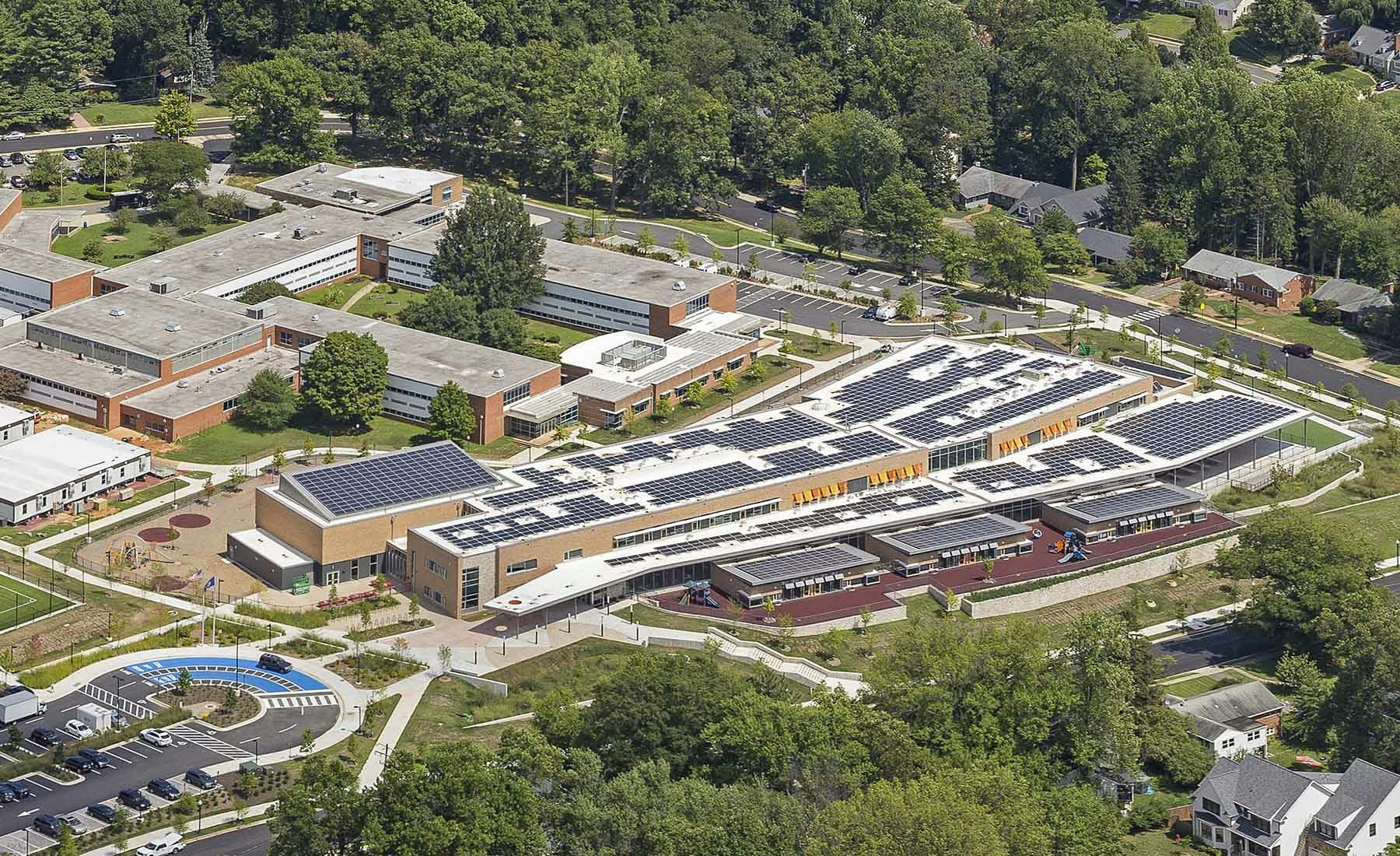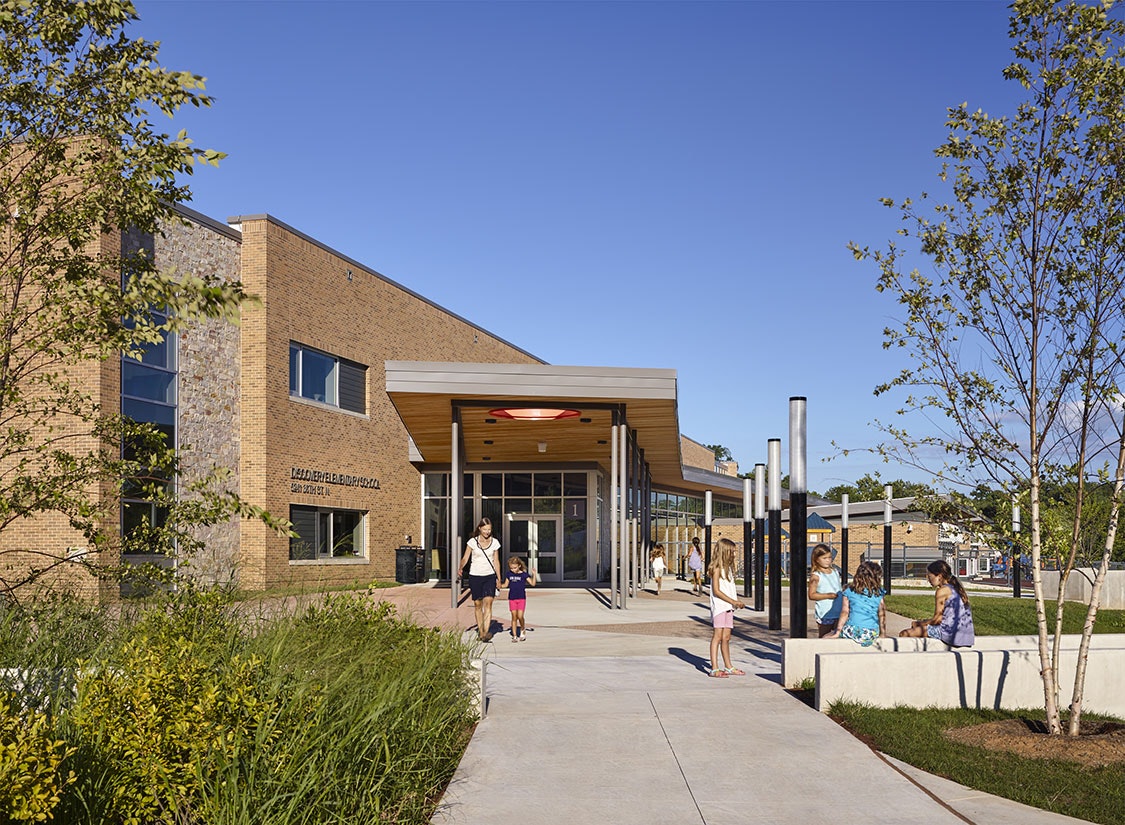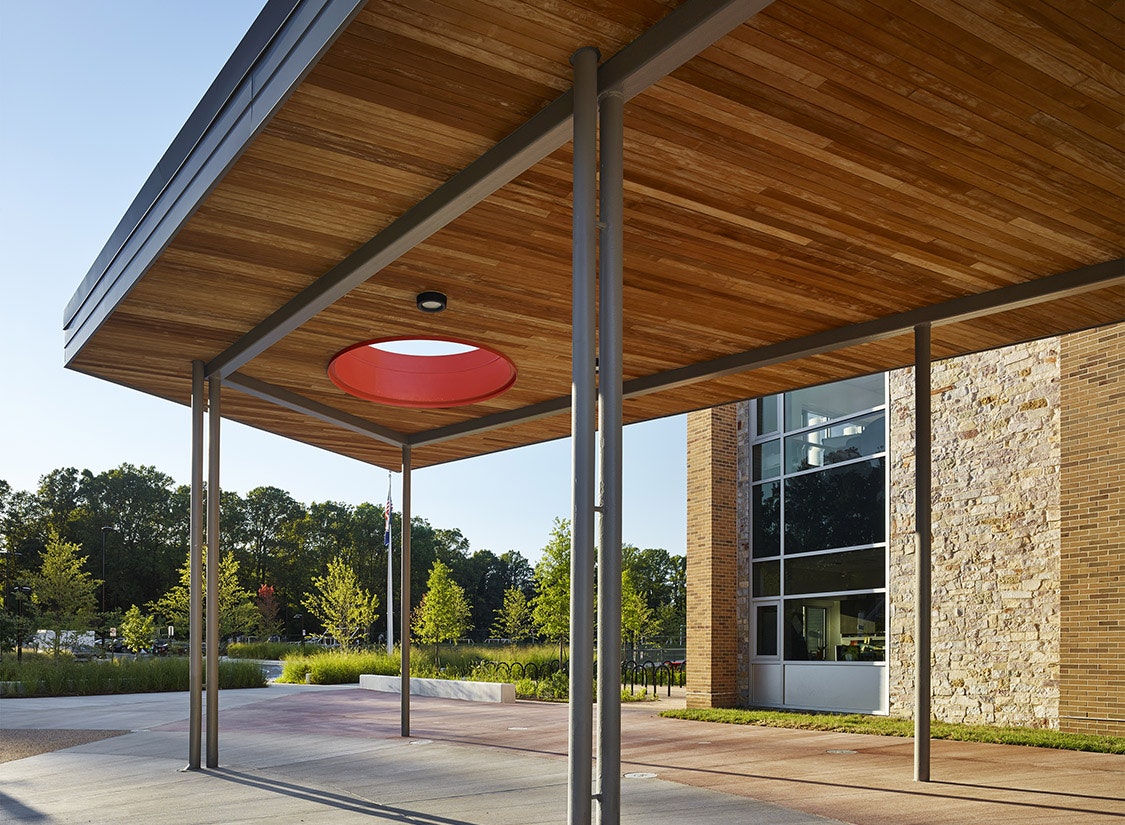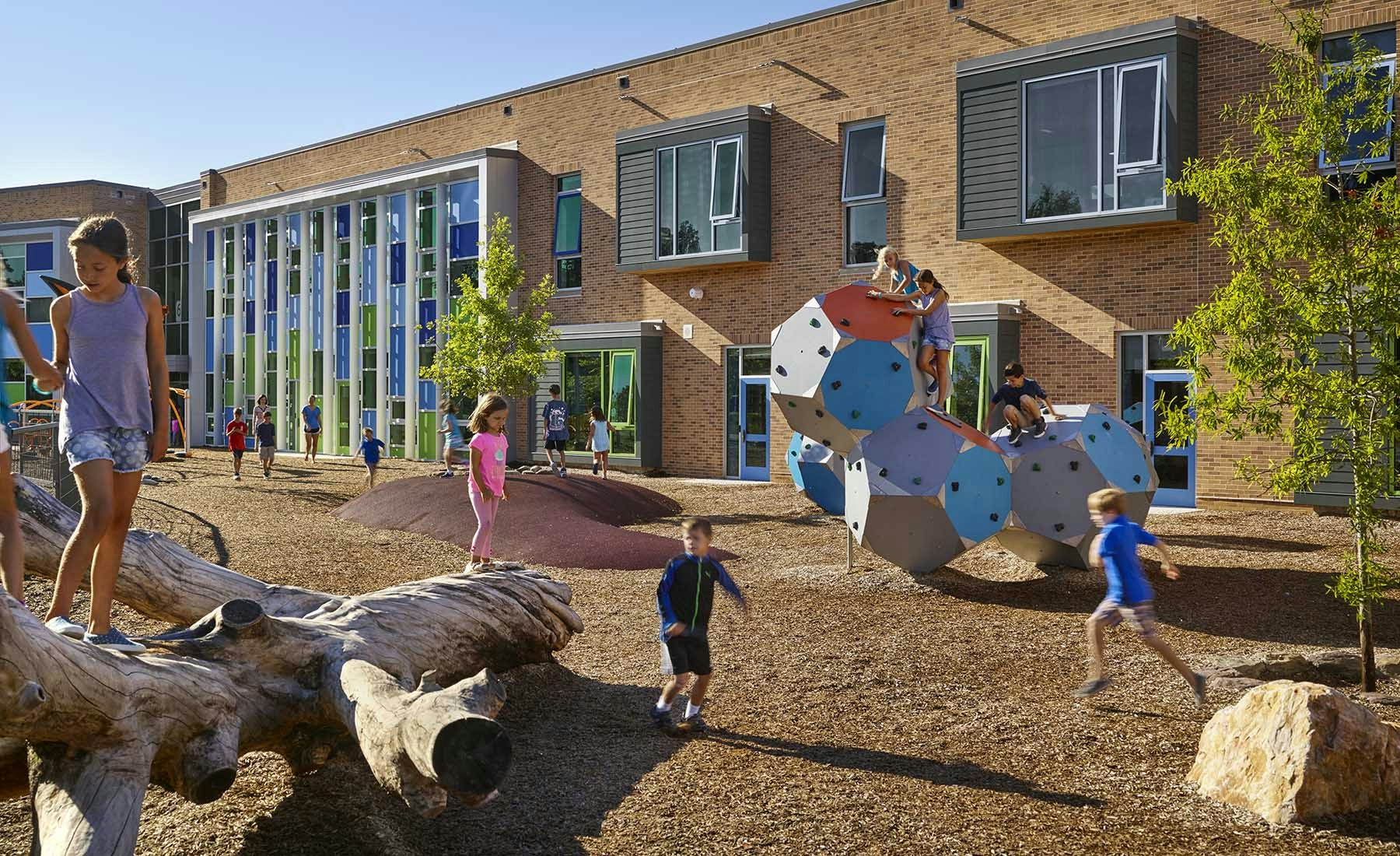Discovery Elementary School is Arlington Public Schools’ first elementary school designed in the 21st century. While built to address rapidly growing student enrollment in Arlington, the school was designed to meet a larger goal – to prove what can truly be achieved with a new public school facility. To this end, careful attention was focused on designing and building a school that supports how and where students learn. Every nook and cranny of the school is arranged to create a seamless integration between design, sustainability, and learning. Recognizing that students are the creators of our collective future, Discovery Elementary sets the stage for the development of the skills necessary for long-term stewardship of our world.
The school was designed to be a zero-energy building, meaning that the amount of energy produced annually by on-site renewable energy sources is equal to the amount of energy used annually. The school has been a trailblazer for zero-energy schools, both in demonstrating performance and engaging students in the "building as a teaching tool":
- Discovery Elementary School is the first school and third project ever to receive the U.S. Green Building Council’s LEED Zero Energy certification.
- Discovery is the first recipient of the USGBC National Capital Region’s Net Zero Award and is the only building in the National Capital Region to date to demonstrate a net-positive energy balance.
- Discovery is one of the largest zero-energy buildings of any kind anywhere in the world and the first to receive Zero Energy certification by the collaborative partnership of the International Living Future Institute and New Buildings Institute.
Nestled near the nation’s capital, Arlington County is one of the fastest growing counties in Virginia. As such, the need for contextual sensitivity with the rapidly urbanizing neighborhood and adaptability for after-hours use were top concerns. The school shares the site with an existing middle school and has been master planned for future middle school expansion. Open, programmable space is preserved as much as possible by situating a full third of the building’s footprint on existing slopes. The school tiers into an existing hill to minimize the perception of its size while featuring exterior materials that are residential in nature and scale. Pre-K and Kindergarten students are grouped into three “kinderhouses” that mimic the size and spacing of adjacent homes.
To support ownership of the new school, the mascot, colors and school name were chosen by a vote of the student body. The “Discovery Explorers” name reflects the forward-looking, inquiry-based learning that takes place in the building. The school name also serves as a tribute to John Glenn, who lived adjacent to the site when he became the first American to orbit the earth in 1962. In 1998, while still a sitting senator, Glenn returned to space as a crew member of the space shuttle Discovery, becoming the oldest person to fly in space.
The school’s design takes advantage of the topography of the site to create distinct, tiered academic zones and separate exterior play spaces for early childhood, primary, and elementary grade levels. Discovery’s public spaces are defined by a large roof canopy with a cedar soffit that runs the length of the school and serves as the school’s “front porch.” At the main entry, the roof extends out as a canopy with an oculus, which allows the entry plaza to serve as a large solar calendar that indicates both time of day and time of year.
Light is celebrated in multiple ways throughout the school, culminating in a rooftop solar lab that allows students to conduct real time and on-going experiments. Data from these experiments can be tracked and graphed using a building dashboard system accessible on any device in the school. The street side of the school is accented with warm colors – reflecting their south-facing solar orientation. On the north side, the school uses playful arrangements of cool colors, such as greens and blues, echoing the natural expression of moss that grows on the north side of trees.
The school’s wayfinding goes beyond basic navigation to support a larger vision of spatial organization that reflects each grade’s expanding curriculum and identity. As students progress through the school, their “world expands” – with the first floor themed around animals found in earth eco-systems and the second floor themed around the elements of the sky and heavens. Students start out as Backyard Adventurers in Kindergarten and finish Fifth Grade as Galaxy Voyagers. This storyline is graphically communicated along an entry wall highlighting each Explorer grade level. On the first day of school, Explorers are able to “make their mark” in their expanding world by signing their name on the wall – and follow along as the mark moves down the wall over their six year journey at Discovery.
Discovery isn’t just a school building. Every aspect of the environment is built for and used for learning. We aspire to its example, and strive to implement innovative, research-based, future-proof practices that mirror the potential of this space.
Educational Technology Administrator, Discovery Elementary School
Discovery Elementary inspires students and teachers to use the building creatively to facilitate everyday learning and lifelong exploration. To support engagement at every scale, the school features an extensive array of exterior playscapes and interior furniture including stools, bean bags, benches, height-adjustable tables and chairs, reading steps, and even a two-story slide – all of which encourage creative expression and student choice.
Inside classrooms, flexible details such as foldable partitions, retractable garage doors, and various furniture offerings support teacher collaboration and cross-pollination. Throughout the school, one-to-one technology enables research and collaboration to happen anytime, anywhere. Dry erase and magnetic creativity walls encourage student expression and ownership; Scrabble and Lego walls fuel linguistic and spatial exploration; and the “Hedge” (which encloses and defines the Kindergarten “Backyard”) provides nooks and crannies that buzz with activity before, during, and after school.
With a reconfigurable range of learning spaces, the positive correlation between learning, high performance architecture, and student engagement continues to find expression in all types of unanticipated ways – demonstrating that Discovery should continue to provide meaningful settings for educational practices that are always evolving.
Innovative projects like Discovery Elementary School are critical to transforming our buildings, spaces, and places so that they can continue to sustain future generations. Giving students the opportunity to see and experience their school building as a living laboratory encourages greater understanding and stewardship for their planet and community. By setting high goals for energy performance and involving students in the effort, Discovery demonstrates a new threshold of academic and industry leadership.
CEO, United States Green Building Council (USGBC)
Client: Arlington Public Schools
Location: Arlington, VA
Discipline: Primary & Elementary Schools
Completion: 2015
Performance: EUI -3 kBTU/sf/year (measured) | 107% reduction (regional CBECs 2003 K12 School baseline)
Size: 98,000 SF
Key Team Members
Additional Resources
Discovery Elementary School Case Study
Discovery Elementary School Videos
---
Architect Magazine: What It Takes to Get to Net-Zero
Architectural Record: Active Design
ASHRAE: Advanced Energy Design Guide for K12 School Buildings
Department of Energy: Zero Energy Schools—Architects Take the Lead
Education Week: Energy Efficiency Is Built into the Mission at 'Green Schools'
High Performance Building Magazine: Earning the Energy Grade
NEA Today: Challenging the Traditional Definition of a Learning Space
Net Zero Buildings Magazine: Discovery Elementary School
Washington Post: Discovery Elementary School as a Teaching Tool
Awards Received
2021 Livable Building Award
UC Berkeley Center for the Built Environment
2020 World Changing Ideas: Honorable Mention, Education
Fast Company Magazine
2020 World Changing Ideas: Honorable Mention, Spaces, Places, and Cities
Fast Company Magazine
2019 Inaugural Net Zero Award
USGBC National Capital Region
2019 Community Champion Award
USGBC Virginia
2019 ICF Builder Awards First Place
ICF Builder Magazine
2018 First Place Academic Project
Virginia Energy Efficiency Leadership Awards
2018 First Place Technology Award
ASHRAE Region VII
2017 AIA COTE Top Ten Award Winner
American Institute of Architect's Committee on the Environment (COTE)
2017 Green Ribbon School
U.S. Department of Education
2017 Presidential Citation for Sustainability
AIA|DC
2017 Platinum Design Award
Virginia School Boards Association
2017 Special Jury Recognition Award
Virginia Chapter of the Association for Learning Environments
2016 Project of Distinction
Association for Learning Environments
2016 Honor Award
AIA Central Virginia
Fall 2016 Honorable Mention
Learning By Design
2015 Award of Excellence
Design Arlington Awards






